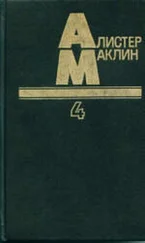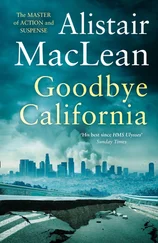Alistair MacLean
GOODBYE CALIFORNIA
1978
It was at twenty seconds to six o’clock on the morning of 9 February 1972 that the earth shook. As such tremors go it could hardly even be called noteworthy; it was certainly no more remarkable than those that afflict the citizens of Tokyo and its surrounding countryside scores of times a year. Pendant lamps oscillated briefly, some precariously balanced objects fell from their shelves, but those were the only discernible effects of the passing of the earth ripple. The aftershock, considerably weaker, came twenty seconds later. It was learnt afterwards that there had been four more aftershocks, but those were of so low a magnitude that they registered only on the seismographs. Altogether a rather inconsequential affair, but memorable for me, at least, inasmuch as it was the first-ever tremor I had experienced: having the ground move beneath your feet provides a distinctly disquieting sensation.
The area where the maximum damage had occurred lay only a few miles to the north and I drove out to see it, but not until the following day – partly because of reports of fissured roads, damaged viaducts and burst water mains but chiefly because the authorities bend an unkindly eye on rubber-neckers whose unwanted presence interferes with the efforts of rescue and medical teams.
The township of Sylmar, which had borne the brunt of the earthquake, lies in the San Fernando Valley in California, some miles north of Los Angeles – in fact, so unconscionably sprawling is that city that it encompasses Sylmar within its boundaries. To the untutored eye the scene in that town appeared to be one of considerable confusion, with wreckers, bulldozers and trucks milling around at apparent random, but this was entirely illusory: all activities were highly organized and under central control. Unlike their more unfortunate brethren in, say, Nicaragua or Guatemala or the Philippines, places sadly accustomed to being side-swiped by much more than their fair share of earthquakes, the Californians are not only prepared for but are highly geared to deal efficiently with the aftermaths of natural disasters: the San Franciscans, for instance, have fifteen hospitals in kit form distributed at various key points around their city in preparation for the next earthquake which is widely and more than a little fearfully regarded as inevitable.
Damage to buildings was widespread but not severe – except in one very localized area. This was, or to a considerable extent had been, the Veterans’ Administration Hospital. Before the earthquake it had consisted of three parallel blocks of buildings. The two outer blocks had remained virtually intact: the central one had collapsed like a house of cards. Destruction was total; no part of it was left standing. Over sixty patients died.
The contrast between this ruin and the virtual immunity of the two sister blocks would have seemed incomprehensible to anyone without some knowledge of the Californian building codes. With some such knowledge it was all too readily understandable. The city of Los Angeles has the misfortune to have its very own private and personal structure fault running under its streets. This is known as the Newport-Inglewood Fault, and when one side of the fault suddenly jerked forward in respect to the other in 1933 it produced the Long Beach earthquake in which a disconcertingly large number of buildings fell down, solely because they had been shoddily built on unreinforced, made-up ground.
This prompted the authorities to introduce a new building code, designed to result in structures as nearly earthquake-proof as possible, a code that is as rigorously enforced as it is rigorous in nature, and it was under the enforcements of this code that the two outer blocks of the Veterans’ Hospital had been built, one in the late 1930s, the other in the late 1940s: the destroyed block had been constructed in the mid-twenties.
Nevertheless, it had been destroyed by an earthquake the epicentre of which had been some eight miles distant to the north-east. But what was important – and significant – about the earthquake that had caused this considerable damage was the factor of its power – or lack of it. The power, or magnitude, of an earthquake is registered on an arbitrarily chosen Richter scale which ranges from zero to twelve. And what is important to bear in mind is that the Richter scale progresses not arithmetically but logarithmically. Thus, a six on the Richter scale is ten times as powerful as a five or a hundred times as powerful as a four. The San Fernando earthquake which levelled this hospital block in Sylmar registered six-point-three on the Richter scale: the one that wreaked havoc on San Francisco in 1906 registered seven-point-nine (according to the recent modifications of the Richter scale). Thus, the earthquake that caused this damage in Sylmar was possessed of only one per cent of the effective power of the San Francisco one. It is a sobering and, to those burdened with an over-active imagination, a fearful reflection.
What is even more sobering and frightening is the fact that, to the best of our knowledge, no great earthquake – ‘great’ is arbitrarily taken to be anything eight and above on the Richter scale – has ever occurred beneath or in the immediate vicinity of any major city. (Such a disaster may have occurred in that awesome North Chinese earthquake of 1976 when a third of a million people are reported to have died: but the Chinese have dropped a total news blanket over this tragedy.) But the law of averages would indicate strongly that somewhere, some time, a major earthquake will occur in a place which is not conveniently uninhabited or, at least, sparsely populated. There is no reason not to imagine, unless one chooses to take refuge behind I-don’t-want-to-know mental blinkers, that this possibility may even today be a probability.
The word ‘probability’ is used because the law of averages is strengthened by the fact that with the exception of China, Turkey and, to a lesser extent, Italy, earthquakes largely tend to take place in coastal areas, whether those coastal areas be of land masses or islands; and it is in those coastal areas, for the purposes of trade and because they are the points in ingress to the hinterland, that many of the world’s great cities have been built. Tokyo, Los Angeles and San Francisco are three such examples.
That earthquakes should be largely confined to those areas is in no way fortuitous: their cause, as well as that of volcanoes, is now a matter of almost universal agreement among geologists. The theory is simply that in the unimaginably distant past when land first appeared it was in the form of one gigantic super-continent surrounded by – inevitably – one massive ocean. With the passage of time and for reasons not yet definitely ascertained this super-continent broke up into several different continental masses, which, borne on what are called their ‘tectonic plates’ – which float on the still molten magma layer of the earth – drifted apart. Those tectonic plates occasionally bang or rub against one another; the effects of the collisions are transmitted either to the land above or the ocean floor and appear in the form of earthquakes or volcanoes.
Most of California lies on the North American plate which, while tending to move westward, is not the real villain of the piece. That unhappy distinction belongs to that same North Pacific plate which deals so hardly with China, Japan and the Philippines and on which that section of California lying to the west of the San Andreas Fault so unhappily lies. Although the North Pacific plate appears to be rotating slightly, its movement in California is still roughly to the north-west and, now and then, when the pressure between the two plates becomes too much, the North Pacific plate eases this pressure by jerking north-west along the San Andreas Fault and so producing one of those earthquakes that Californians don’t care so much about.
Читать дальше
Конец ознакомительного отрывка
Купить книгу










